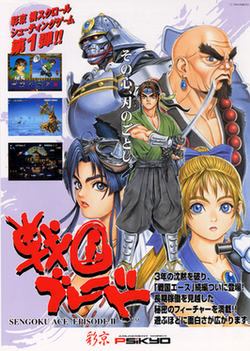Sengoku Blade: Sengoku Ace Episode II
| Sengoku Blade | |
|---|---|

Japanese arcade flyer
|
|
| Developer(s) | Psikyo |
| Publisher(s) | Psikyo Taito (PS2) Atlus (SAT) Blue Bean Soft (Korea) MOBIRIX (mobile) |
| Designer(s) | Hirofumi Nakamura |
| Artist(s) | Tsukasa Jun |
| Composer(s) | Masaki Izutani |
| Series | Sengoku Ace |
| Platform(s) | Arcade, Sega Saturn, PlayStation 2, iOS, Android |
| Release |
Arcade
|
| Genre(s) | Shoot 'em up |
| Mode(s) | Single player, co-op |
| Cabinet | Horizontal |
Sengoku Blade, also known as Tengai, is a horizontally scrolling shoot 'em up video game released for arcade machines in 1996 by Psikyo as a sequel to their 1993 shooter Sengoku Ace. A home console version was also released for the Sega Saturn. The game was ported years later to the PlayStation 2, and again for iOS and Android devices. The game is set in a historical fantasy version of the Sengoku period of Japanese history, featuring demons, magic and steam-powered robotics. It was followed by Sengoku Cannon: Sengoku Ace Episode III, released for the PlayStation Portable in 2005.
Sengoku Blade is horizontal-scrolling shoot 'em up. The player may choose from five playable characters at the start and may unlocked two more. The game takes place in an imaginative and futuristic version of feudal Japan featuring ninjas and steam-powered machinery. The Saturn version provides an option to choose a difficulty level between 1 and 7, configure controls, and set the amount of lives between 1 and 4. Items include a power-up to increase weapon power level, bombs, and bonus coins to increase score. Holding down the standard shot button can provide a more powerful shot. If the player touches an enemy ship, their weapon power level will drop by one. The player will lose a life if they get hit by an enemy bullet. If all lives are lost, continues are provided. Once the game is beaten once, a second round will begin without the ability to use continues. Score rankings and other options can be saved to the system's memory.
Originally released for the arcades in 1996, Sengoku Blade was first ported to the Sega Saturn on November 22 of that same year. This version was released as a two-disc double set, including a bonus omake CD-ROM which featured hundreds of Sengoku Ace series artworks (including the official art, guest art, and fan art from a contest by Psikyo), and now is rare and expensive to obtain. Exclusive for the Saturn conversion was the implementation of voices during the brief cut scenes, and the addition of Marion from the Gunbird series as a bonus hidden character.
...
Wikipedia
